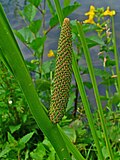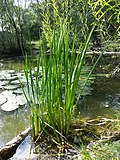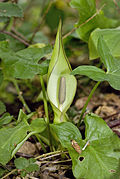List of alismatid families
(Redirected from
List of alismatid monocot families
)
| Flowering plant families (APG IV) | |||||
|---|---|---|---|---|---|
|
|
|||||
| Early-diverging flowering plants | |||||
| Monocots: Alismatids • Commelinids • Lilioids | |||||
|
|
|||||
Eudicots
|
The
veins, flowers with parts in threes or multiples of three, and roots that can develop in more than one place along the stems.[6] The alismatids have adapted to thrive in oceans, temperate zones, deserts, the tropics, and even glacial regions.[7]
Like the earliest monocots, many of the alismatid monocots are
titan arum, with the world's largest unbranched inflorescence, and also the world's smallest flowering plant, duckweed.[2][5][8][9]
Glossary
From the glossary of botanical terms:
- annual: a plant species that completes its life cycle within a single year or growing season
- evolutionary treediagram)
- climber: a vine that leans on, twines around or clings to other plants for vertical support
- herbaceous: not woody; usually green and soft in texture
- perennial: not an annual or biennial
- woody: hard and lignified; not herbaceous[10]
The
Alismatid families
| Family and a common name[12][b] | Type genus and etymology[c] | Total genera; global distribution | Description and uses | Order[14] | Type genus images |
|---|---|---|---|---|---|
Acoraceae
(sweet-flag family)[15] |
Acorus comes from a Latin plant name.[16][17] | 1 genus, in North America, Europe and Asia[15][18] | Herbaceous aromatic plants with thin, sword-shaped leaves. The rhizomes are essentially non-vascular.[15] | Acorales
|
|
| Alismataceae (water-plantain family)[19] |
Alisma comes from a Greek plant name.[20][21][22] | 18 genera, worldwide[23] | Herbaceous latex-bearing aquatic plants, usually perennials. They take root in freshwater beds, and some remain submerged.[19][24] Two species are consumed in Asia, and another was a food source for Native Americans.[19][24] C4 photosynthesis[d] has been observed in Sagittaria.[8] | Alismatales | |
Aponogetonaceae
(waterblommetjie family)[25] |
Aponogeton is from the Latin for "near (the hot springs at) Aponus".[26] | 1 genus, in Africa, Oceania, and South and Southeast Asia[25][27] | Herbaceous smooth-stemmed freshwater perennials, usually with long leaf-stalks.[28] Cape pondweed flowers are consumed as a delicacy in South Africa; the tubers are also edible.[25] | Alismatales | |
| Araceae (aroid family)[29] |
Arum comes from a Greek plant name.[30][31][32] | 142 genera, worldwide, especially in the tropics[33][34] | Generally sappy, herbaceous plants growing in soil, in water and on trees, along with a few woody climbers. Many cultures have relied on taro plants (which are toxic when raw) as a staple crop.[33][35] | Alismatales | |
Butomaceae
(flowering-rush family)[36] |
Butomus is from the Greek for "ox-wounding", named for the sharp leaves.[37][38] | 1 genus, in temperate Europe and Asia[36][39] | Smooth-stemmed herbaceous aquatic, swamp or marsh plants, usually with milky latex.[40] They are consumed in parts of Russia, in bread or as a vegetable.[36] | Alismatales | |
| Cymodoceaceae (turtle-grass family)[41] |
Cymodocea was named for Cymodoce, a Greek sea nymph.[42][43] | 6 genera, in tropical and warm temperate seas[41][44] | Large perennials,[41] up to 30 cm (12 in) long in the genus Cymodocea.[45] They nourish and shelter many crustaceans and fish that are harvested commercially.[41] | Alismatales | |
| Hydrocharitaceae (frogbit family)[46] |
Hydrocharis is from the Greek for "water grace".[47][48] | 14 genera, worldwide[46][49] | Annual and perennial aquatic plants. One species is consumed in Asia. Many invasive genera have become entrenched, causing considerable economic damage.[46] | Alismatales | |
| Juncaginaceae (arrowgrass family)[50] |
Juncago (an earlier synonym for the type genus, Triglochin) is from the Latin for "a rush-like plant".[50][51] | 3 genera, in northern temperate zones, South America, Oceania and parts of Africa[50][52] | Herbaceous plants with grass-like leaves that grow in soil or water.[50][53] Two species are edible.[50] | Alismatales | |
Maundiaceae
(Maund's-arrowgrass family)[54] |
Maundia was named for John Maund (1823–1858), a physician and chemist.[55] | 1 genus, in eastern Australia[54][56] | Aquatic perennials with leaves up to 80 cm (31 in) long. The family is likely to become endangered as water tables recede in eastern Australia.[54] | Alismatales | |
Posidoniaceae
(tapeweed family)[57] |
Posidonia was named for Poseidon, a Greek god.[58] | 1 genus, in the Mediterranean and oceans south and west of Australia[57][59] | Submerged plants with long linear leaves. Genetically identical beds of Posidonia oceanica in the Mediterranean can be kilometers wide and persist for many thousands of years.[57] | Alismatales | |
| Potamogetonaceae (pondweed family)[60] |
Potamogeton comes from Greek and Latin plant names.[61][62] | 5 genera, worldwide[60][63] | Aquatic plants, usually perennials.[60][64] The plants are an important food source for many birds and aquatic animals.[60] | Alismatales | |
Ruppiaceae
(tasselweed family)[57] |
Ruppia was named for Heinrich Bernhard Ruppius (1688–1719).[65] | 1 genus, scattered worldwide, in ponds, marshes and shallow seas[57][66] | Submerged herbaceous plants, usually annuals with stalkless leaves[57][67] | Alismatales | |
Scheuchzeriaceae
(Rannoch-rush family)[68] |
Johann Jacob.[69]
|
1 genus, in arctic sphagnum bogs[68][70] | Perennial aquatic plants. The linear leaves have parallel veins.[68] | Alismatales | |
| Tofieldiaceae (false-asphodel family)[71] |
Tofieldia was named for Thomas Tofield (1730–1779).[72][73] | 4 genera, mostly in northern | Herbaceous rhizomatous perennials, usually with leaves attached at the plant's base[71][75] | Alismatales | |
| Zosteraceae (eelgrass family)[76] |
Zostera is from the Greek for "belt".[76][77] | 2 genera, in temperate and subtropical sea beds[76][78] | Perennials with simple leaves.[76][79] The plants have been used as packing material. The dense growths support commercially important fish and shrimp.[76] | Alismatales |
See also
Notes
- ^ The taxonomy (classification) in this list follows Plants of the World (2017)[1] and the fourth Angiosperm Phylogeny Group system.[2] Total counts of genera for each family come from Plants of the World Online.[3] (See the POWO license.) Extinct taxa are not included. The monocots as a whole are the plants responsible for most of the global agricultural output, including those in the grass, palm, banana, ginger, asparagus, pineapple, sedge and onion families.[4][5]
- ^ Each family's formal name ends in the Latin suffix -aceae and is derived from the name of a genus that is or once was part of the family.[13]
- ^ Some plants were named for naturalists (unless otherwise noted).
- ^ See Photosynthesis#C3 : C4 photosynthesis research for the chemistry of C4 photosynthesis.
Citations
- ^ Christenhusz, Fay & Chase 2017.
- ^ a b c Angiosperm Phylogeny Group 2016.
- ^ POWO.
- ^ Givnish et al. 2010, p. 585.
- ^ a b Royal Botanic Gardens.
- ^ Christenhusz, Fay & Chase 2017, pp. 115–116.
- ^ Christenhusz, Fay & Chase 2017, pp. 115–131.
- ^ a b c Stevens 2023.
- ^ Christenhusz, Fay & Chase 2017, pp. 117–120.
- ^ Christenhusz, Fay & Chase 2017, pp. 638–670.
- ^ Christenhusz, Fay & Chase 2017, pp. 10, 117.
- ^ Christenhusz, Fay & Chase 2017, pp. 117–131.
- ^ ICN, art. 18.
- ^ Stevens 2023, Summary of APG IV.
- ^ a b c Christenhusz, Fay & Chase 2017, p. 117.
- ^ Coombes 2012, p. 30.
- ^ Stearn 2002, p. 30.
- ^ POWO, Acoraceae.
- ^ a b c Christenhusz, Fay & Chase 2017, p. 122.
- ^ Coombes 2012, p. 36.
- ^ Stearn 2002, p. 38.
- ^ IPNI, Alismataceae, Type.
- ^ POWO, Alismataceae.
- ^ a b POWO, Alismataceae, Flora of Tropical East Africa.
- ^ a b c Christenhusz, Fay & Chase 2017, p. 126.
- ^ Stearn 2002, p. 48.
- ^ POWO, Aponogetonaceae.
- ^ POWO, Aponogetonaceae, Flora of Somalia.
- ^ POWO, Araceae, Neotropikey.
- ^ Coombes 2012, p. 52.
- ^ Stearn 2002, p. 53.
- ^ IPNI, Araceae, Type.
- ^ a b Christenhusz, Fay & Chase 2017, pp. 118–120.
- ^ POWO, Araceae.
- ^ POWO, Rapateaceae, Flora of West Tropical Africa.
- ^ a b c Christenhusz, Fay & Chase 2017, p. 123.
- ^ Coombes 2012, p. 72.
- ^ Stearn 2002, p. 73.
- ^ POWO, Butomaceae.
- ^ POWO, Butomaceae, Flora of Tropical East Africa.
- ^ a b c d Christenhusz, Fay & Chase 2017, p. 131.
- ^ Burkhardt 2018, p. C-77.
- ^ IPNI, Cymodoceaceae, Type.
- ^ POWO, Cymodoceaceae.
- ^ POWO, Cymodoceaceae, Flora of Somalia.
- ^ a b c Christenhusz, Fay & Chase 2017, pp. 123–125.
- ^ Stearn 2002, p. 170.
- ^ IPNI, Hydrocharitaceae, Type.
- ^ POWO, Hydrocharitaceae.
- ^ a b c d e Christenhusz, Fay & Chase 2017, pp. 126–127.
- ^ USDA, Juncaginaceae, Type.
- ^ POWO, Juncaginaceae.
- ^ POWO, Juncaginaceae, Flora of Tropical East Africa.
- ^ a b c Christenhusz, Fay & Chase 2017, p. 127.
- ^ Burkhardt 2018, p. M-34.
- ^ POWO, Maundiaceae.
- ^ a b c d e f Christenhusz, Fay & Chase 2017, p. 130.
- ^ Burkhardt 2018, p. P-60.
- ^ POWO, Posidoniaceae.
- ^ a b c d Christenhusz, Fay & Chase 2017, pp. 128–129.
- ^ Stearn 2002, p. 247.
- ^ IPNI, Potamogetonaceae, Type.
- ^ POWO, Potamogetonaceae.
- ^ POWO, Potamogetonaceae, Flora of Tropical East Africa.
- ^ Burkhardt 2018, p. R-55.
- ^ POWO, Ruppiaceae.
- ^ POWO, Ruppiaceae, Neotropikey.
- ^ a b c Christenhusz, Fay & Chase 2017, p. 125.
- ^ Burkhardt 2018, p. S-22.
- ^ POWO, Scheuchzeriaceae.
- ^ a b c Christenhusz, Fay & Chase 2017, p. 121.
- ^ Burkhardt 2018, p. T-26.
- ^ USDA, Tofieldiaceae, Type.
- ^ POWO, Tofieldiaceae.
- ^ POWO, Tofieldiaceae, Neotropikey.
- ^ a b c d e Christenhusz, Fay & Chase 2017, pp. 127–128.
- ^ IPNI, Zosteraceae, Type.
- ^ POWO, Zosteraceae.
- ^ POWO, Zosteraceae, Neotropikey.
References
- Angiosperm Phylogeny Group (2016). "An update of the Angiosperm Phylogeny Group classification for the orders and families of flowering plants: APG IV". Botanical Journal of the Linnean Society. 181 (1): 1–20. .
- Burkhardt, Lotte (2018). Verzeichnis eponymischer Pflanzennamen – Erweiterte Edition [Index of Eponymic Plant Names – Extended Edition] (pdf) (in German). Berlin: Botanic Garden and Botanical Museum, Freie Universität Berlin. .
- Christenhusz, Maarten; Fay, Michael Francis; Chase, Mark Wayne (2017). Plants of the World: An Illustrated Encyclopedia of Vascular Plants. Chicago, Illinois: Kew Publishing and The University of Chicago Press. ISBN 978-0-226-52292-0.
- Coombes, Allen (2012). The A to Z of Plant Names: A Quick Reference Guide to 4000 Garden Plants. Portland, Oregon: Timber Press. ISBN 978-1-60469-196-2.
- S2CID 15036227. Retrieved October 23, 2022.
- IPNI (2022). "International Plant Names Index". London, Boston and Canberra: Royal Botanic Gardens, Kew; Harvard University Herbaria & Libraries; and the Australian National Botanic Gardens. Retrieved October 21, 2022.
- POWO (2019). "Plants of the World Online". London: Royal Botanic Gardens, Kew. Archived from the original on March 22, 2017. Retrieved October 23, 2022. See the terms of their license.
- Royal Botanic Gardens, Kew (2010). "Monocots I: General Alismatids & Lilioids". London: Royal Botanic Gardens, Kew. Archived from the original on September 14, 2015. Retrieved October 19, 2022.
- Stearn, William (2002). Stearn's Dictionary of Plant Names for Gardeners. London: Cassell. ISBN 978-0-304-36469-5.
- Stevens, P.F. (2023) [2001]. "Angiosperm Phylogeny Website. Alismatales". Missouri Botanical Garden. Retrieved October 22, 2022.
- Turland, N. J.; et al. (eds.). International Code of Nomenclature for algae, fungi, and plants (Shenzhen Code) adopted by the Nineteenth International Botanical Congress Shenzhen, China, July 2017 (electronic ed.). Glashütten: International Association for Plant Taxonomy. Retrieved February 25, 2022.
- "USDA, Agricultural Research Service, National Plant Germplasm System". Germplasm Resources Information Network (GRIN Taxonomy). Beltsville, Maryland: National Germplasm Resources Laboratory. 2022. Retrieved October 29, 2022.
































